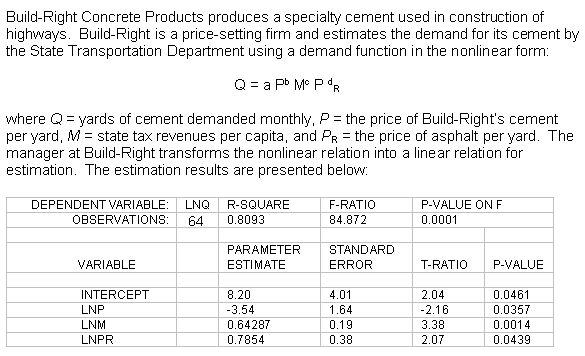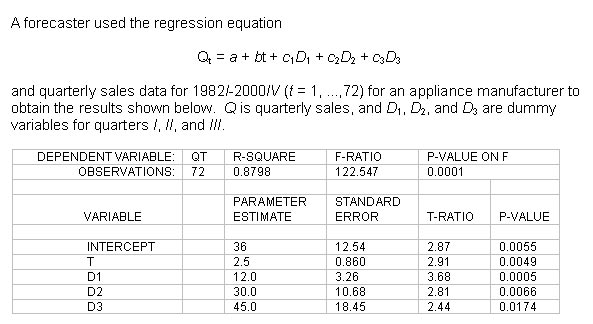 |
1 |  | 
One problem in the estimation of market demand equations is that... |
|  | A) | demand and supply determine both price and quantity. |
|  | B) | exogenous variables are sometimes determined outside the system of equations. |
|  | C) | two-stage least squares is a complicated technique. |
|  | D) | both a and b |
|  | E) | all of the above |
 |
 |
2 |  | 
The next 4 questions refer to the following:
The estimated demand for a good is
Q = 3,600 − 12P + 0.6M − 2.5PR
where Q is the quantity demanded of the good, P is the price of the good, M is income, and PR is the price of related good R.
The coefficient on P |
|  | A) | violates the law of demand. |
|  | B) | is negative as dictated by the law of demand. |
|  | C) | should not have the same sign as the coefficient on PR. |
|  | D) | should not be greater than one (in absolute value). |
|  | E) | both c and d |
 |
 |
3 |  | 
The good is... |
|  | A) | an inferior good since the coefficient on PR is negative. |
|  | B) | a normal good since the coefficient on PR is negative. |
|  | C) | a normal good since the coefficient on M is positive. |
|  | D) | an inferior good since the coefficient on M is less than one (1). |
|  | E) | none of the above |
 |
 |
4 |  | 
This good and good R are... |
|  | A) | complements since the coefficient on M is positive. |
|  | B) | substitutes since the coefficient on M is positive. |
|  | C) | substitues since the coefficient on PR is negative. |
|  | D) | complements since the coefficient on PR is negative. |
|  | E) | none of the above |
 |
 |
5 |  | 
If income decreases by $1,000, all else constant, quantity demanded will ________ by _________ units. |
|  | A) | increase; 60 units |
|  | B) | decrease; 60 units |
|  | C) | decrease; 1600 units |
|  | D) | decrease; 600 units |
 |
 |
6 |  | 
For a nonlinear demand function of the form Q = aPbMcPRd the estimated income elasticity is... |
|  | A) | c. |
|  | B) | -c. |
|  | C) | c(M/P). |
|  | D) | c(M/Q). |
|  | E) | c(Q/M ). |
 |
 |
7 |  | 
A demand function is identified if... |
|  | A) | the supply function contains at least one exogenous variable that is not in the demand function. |
|  | B) | the supply function contains at least one endogenous variable that is not in the demand function. |
|  | C) | the demand function contains at least one exogenous variable that is not in the supply function. |
|  | D) | the demand function contains at least one endogenous variable that is not in the supply function. |
 |
 |
8 |  | 
The next 6 questions refer to the following:
 <a onClick="window.open('/olcweb/cgi/pluginpop.cgi?it=gif::::/sites/dl/free/0070601607/124368/chap7_11.gif','popWin', 'width=635,height=426,resizable,scrollbars');" href="#"><img valign="absmiddle" height="16" width="16" border="0" src="/olcweb/styles/shared/linkicons/image.gif"> (8.0K)</a> <a onClick="window.open('/olcweb/cgi/pluginpop.cgi?it=gif::::/sites/dl/free/0070601607/124368/chap7_11.gif','popWin', 'width=635,height=426,resizable,scrollbars');" href="#"><img valign="absmiddle" height="16" width="16" border="0" src="/olcweb/styles/shared/linkicons/image.gif"> (8.0K)</a>
The estimated demand for cement is... |
|  | A) | elastic because Ê = 8.2. |
|  | B) | elastic because Ê = -3.54. |
|  | C) | elastic because Ê = -2.16. |
|  | D) | inelastic because Ê = -0.357. |
|  | E) | inelastic because Ê = -0.461. |
 |
 |
9 |  | 
At the 5% level of significance, the number of degrees of freedom for a t-test is _____, and the critical value of the t-statistic is ________. |
|  | A) | 63; 1.671 |
|  | B) | 64; 2.000 |
|  | C) | 60; 1.671 |
|  | D) | 60; 2.000 |
 |
 |
10 |  | 
At the 5% level of significance, which parameter estimates are statistically significant? |
|  | A) |  <a onClick="window.open('/olcweb/cgi/pluginpop.cgi?it=gif::::/sites/dl/free/0070601607/124368/chap7_13a.gif','popWin', 'width=90,height=86,resizable,scrollbars');" href="#"><img valign="absmiddle" height="16" width="16" border="0" src="/olcweb/styles/shared/linkicons/image.gif"> (0.0K)</a> <a onClick="window.open('/olcweb/cgi/pluginpop.cgi?it=gif::::/sites/dl/free/0070601607/124368/chap7_13a.gif','popWin', 'width=90,height=86,resizable,scrollbars');" href="#"><img valign="absmiddle" height="16" width="16" border="0" src="/olcweb/styles/shared/linkicons/image.gif"> (0.0K)</a> |
|  | B) |  <a onClick="window.open('/olcweb/cgi/pluginpop.cgi?it=gif::::/sites/dl/free/0070601607/124368/chap7_13b.gif','popWin', 'width=130,height=89,resizable,scrollbars');" href="#"><img valign="absmiddle" height="16" width="16" border="0" src="/olcweb/styles/shared/linkicons/image.gif"> (0.0K)</a> <a onClick="window.open('/olcweb/cgi/pluginpop.cgi?it=gif::::/sites/dl/free/0070601607/124368/chap7_13b.gif','popWin', 'width=130,height=89,resizable,scrollbars');" href="#"><img valign="absmiddle" height="16" width="16" border="0" src="/olcweb/styles/shared/linkicons/image.gif"> (0.0K)</a> |
|  | C) | none are statistically significant |
|  | D) | all are statistically significant |
 |
 |
11 |  | 
If tax revenue per capita (M) increases 10%, the estimated quantity of cement demanded will |
|  | A) | increase by less than 1%. |
|  | B) | increase more than 1% but less than 5%. |
|  | C) | increase more than 5% but less than 10%. |
|  | D) | increase more than 10%. |
|  | E) | none of the above |
 |
 |
12 |  | 
If the price of asphalt (PR) decreases 15%, the estimated quantity of cement demanded will: |
|  | A) | increase 11.8%. |
|  | B) | decrease 11.8%. |
|  | C) | increase 5.2%. |
|  | D) | decrease 5.2%. |
|  | E) | increase 1.18%. |
 |
 |
13 |  | 
Why can we estimate the demand for a price-setting firm using ordinary least squares whereas market demand estimation requires the more complicated two-stage least squares? |
|  | A) | The manager of the firm sets the price, so there is no simultaneity problem. |
|  | B) | For a firm, there are always exogenous variables in the demand function but not the supply function. |
|  | C) | For a firm, there are always exogenous variables that are in the supply function but not the demand function. |
|  | D) | both a and c |
|  | E) | none of the above |
 |
 |
14 |  | 
A manager-determined price is... |
|  | A) | associated with price-taking firms. |
|  | B) | an exogenous variable in a demand equation. |
|  | C) | not determined by the forces of demand and supply. |
|  | D) | both a and b |
|  | E) | both b and c |
 |
 |
15 |  | 
Time-series models... |
|  | A) | cannot be replicated by another researcher. |
|  | B) | often use dummy variables to control for the time trend. |
|  | C) | often use dummy variables to control for cyclical variation. |
|  | D) | both a and b |
|  | E) | both b and c |
 |
 |
16 |  | 
The next 5 questions refer to the following:
 <a onClick="window.open('/olcweb/cgi/pluginpop.cgi?it=jpg::::/sites/dl/free/0070601607/124368/chap7_q16.jpg','popWin', 'width=643,height=394,resizable,scrollbars');" href="#"><img valign="absmiddle" height="16" width="16" border="0" src="/olcweb/styles/shared/linkicons/image.gif"> (41.0K)</a> <a onClick="window.open('/olcweb/cgi/pluginpop.cgi?it=jpg::::/sites/dl/free/0070601607/124368/chap7_q16.jpg','popWin', 'width=643,height=394,resizable,scrollbars');" href="#"><img valign="absmiddle" height="16" width="16" border="0" src="/olcweb/styles/shared/linkicons/image.gif"> (41.0K)</a>
At the 5 percent level of significance, is there a statistically significant trend in sales? |
|  | A) | No, because 2.50 < 2.66. |
|  | B) | No, because 2.50 < 2.91. |
|  | C) | No, because 2.14 < 2.66. |
|  | D) | Yes, because 2.91 > 2.50. |
|  | E) | Yes, because 2.91 > 2.00. |
 |
 |
17 |  | 
At the 5 percent level of significance, is there a statistically significant trend in sales? |
|  | A) | No, because 0.0049 < 2.00. |
|  | B) | No, because 0.0049 < 0.05. |
|  | C) | Yes, because 0.0049 < 0.05. |
|  | D) | Yes, because 2.14 >0.05. |
|  | E) | Yes, because 0.86 > 0.05. |
 |
 |
18 |  | 
The estimated QUARTERLY increase in sales is ______ units, and the estimated ANNUAL increase in sales is ______ units. |
|  | A) | 2.5; 10 |
|  | B) | 2.5; 36 |
|  | C) | 36; 2.5 |
|  | D) | 9; 36 |
|  | E) | none of the above |
 |
 |
19 |  | 
Using a 5% significance level, these estimation results indicate that |
|  | A) | sales in the first quarter are significantly greater than sales in any other quarter. |
|  | B) | sales in the second quarter are significantly greater than sales in any other quarter. |
|  | C) | sales in the third quarter are significantly greater than sales in any other quarter. |
|  | D) | sales in the fourth quarter are significantly greater than sales in any other quarter. |
 |
 |
20 |  | 
Using the estimation results given above, _______ units. |
|  | A) | 240.5 |
|  | B) | 230.5 |
|  | C) | 218.5 |
|  | D) | 194.5 |
|  | E) | none of the above |
 |

